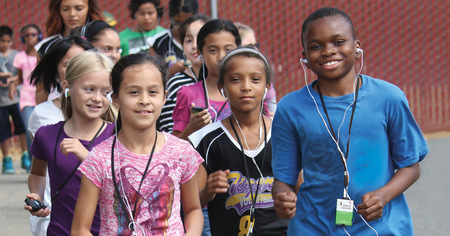Research tells us that reading aloud is instrumental to developing children's literacy skills and success with reading. While reading aloud is common practice with the youngest of children, it is also a significant activity to continue with older youth, including middle school and high school students. Youth of all ages can gain much from participating in read-aloud experiences, and the benefits are abundant. Through read-alouds, youth can:
- Increase their understanding of story structure and exposure to grammar.
- Increase their understanding of more sophisticated vocabulary, beyond the conversational vocabulary heard in everyday speech.
- Be introduced to characters as well as social and moral challenges that mirror situations they deal with everyday and strategies for dealing with those issues.
- Witness modeling of reading fluency and confidence in reading skills.
- Gain the motivation to read independently and the encouragement to try authors and genres they might otherwise overlook.
- Have time to read for pleasure, versus reading school textbooks for "work."
- Cultivate a lifetime love of reading.
Afterschool programs are an ideal environment for offering read-aloud experiences, especially when time and resources might be limited for youth at home. Necessary resources are an interested audience and an alluring tale (free, if borrowed from the school or local library). An effective read-aloud experience requires preparation, enthusiasm and engagement. Reading aloud to youth effectively is a skill that takes practice. The following tips can help with refinement of read-aloud skills, to make read-aloud experiences enjoyable for youth.
Book Selection
Choosing the right book is key to engaging youth in a read aloud. First: Consider stories with an intriguing storyline and characters that reflect youth's interests and experiences.
Second: Consider youth's listening levels. The level at which they can understand text read to them is higher than their independent reading levels, and they can attend to read-aloud stories with more complex structure and vocabulary than stories they read independently. So, choose read-aloud stories that are one-to-two grade levels above the average reading level of youth.
Third: Consider something new that might expand youth's interest in genres and topics, or another story similar to or by the same author as a favorite read-aloud selection.
Last: Discuss possible selections with the school librarian and classroom teachers. Obtain a list of selections youth may be reading aloud during the school day, to avoid duplication.
Empower Youth
Empower youth to have ownership in the read-aloud experience by encouraging them to select the read-aloud story or inviting them to read the story aloud when appropriate.
Pre-Read the Selected Story
Pre-read any story before introducing it to youth, to become familiar with the content and pace of the story as well as points that can lead to discussion. Generate a list of questions to ask youth during the story. Review words and phrases that are unclear and research their meaning. Make notes within the story, anticipating where youth might have questions or a particular reaction to an event.
Time and Place
Plan to read aloud every day. Designate a special area in the program environment with soft seating, such as pillows and beanbag chairs, to host read-aloud sessions. Dedicate 15 to 20 minutes for each read-aloud session, to allow time for reading and for youth to reflect and question.
Introduce the Story
Introduce the story by not only sharing the title, author and illustrator—but also why you chose the story. Develop curiosity about the story by asking engaging questions about the title or cover and inviting youth to make predictions about the story.
Read with Expression
The best way to make any story exciting is to read aloud with expression. Use different voices for each character. Vary pace, volume and tone to dramatize events as they unfold, such as increasing the pace to build excitement and slowing the pace to build suspense. Be aware that youth are not only listening to you read, but are also watching you read. Be sure to make eye contact with youth, and use facial expressions that correspond with the events of the story and the characters' emotions.
Pace Yourself
Keep the reading pace slow enough for youth to ponder and build mental images of the story. Stop and discuss the story as youth have questions, but avoid stopping too frequently as this can affect the story's impact and flow.
Keep Listeners Engaged
Set the stage for the story each time you begin a new read-aloud session. Discuss the events previously read and ideas about upcoming events. As you read, encourage youth to interact with the story by making sound effects and movements that appropriately accompany the story's events. Share illustrations and invite youth to make predictions and interpretations based on the illustrations. Highlight interesting vocabulary and discuss the meaning.
Encourage Discussion
Ask youth questions about the story as you read and invite them to ask questions. Use open-ended questions to illicit more robust responses. Encourage a final discussion of the book at its conclusion, including reflection of story prediction, what youth liked or disliked, interesting events and characters, and how the story relates to youth's personal experiences.
Read Your Listeners
Be aware of the expressions and body language of youth as you read and look for signs indicating interest, confusion or other reactions. Make adjustments to the reading plan based on their reactions and level of engagement, such as shortening or extending your reading time, stopping for questions, or changing your expressions and inflection. Keep in mind it is natural for some youth to fidget or appear inattentive and bored while still listening. Consider providing paper and drawing tools for youth, to draw while they listen.
Enthusiasm
Create excitement for both yourself and youth while reading. Consider adding another dimension to a read aloud by using costumes, props or music. Leave youth wanting more by stopping a reading session at a pivotal event. Reading aloud is as fun as you make it, and youth will respond to your enthusiasm!
Written by Sara Van Dyke, NAA Special Programs Consultant




